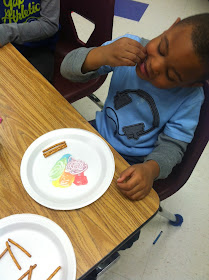I've made one such tweak since attending a 2 day workshop with Dr. Helena Curtain. During the workshop she had us make clock partners. At certain points we would have to walk around the room and have a short conversation with our 3:00 partner then switch and talk to our 7:00 partner. At the end of each conversation she had tell our partner, "Thank you, partner. I really enjoyed talking with you. Goodbye." Or at our tables we might finish up with "du bist intelligent partner. Helena ist super intelligent."
Now I could see the pre-chosen partners working really well in a middle or high school class where you saw the same students every day but not so practical in my class. However, it got me thinking about how I have kids talk in class. We do partner talk with a mix of Whole Brain Teaching and Kagan techniques. And I have the students pat themselves on the back and say "muy bien" when we mark something off the schedule for the day. But I realized that a LOT of the time I have kids just sitting at their tables or on the carpet talking to the same people every time. When I asked questions I would just call on one student at a time while everyone listened (or probably more likely daydreamed.)
So how to fix it so EVERYONE is engaged and talking?
- My afternoon classes are wild. So even though I don't have them have clock partners I do have them stand up and walk around the room to find two partners to ask ¿Cómo estás? rather than having them talk to their shoulder and face partner every time. Already I am seeing better behavior with just that little bit of movement at the beginning of class.
- I'm trying to design things so that EVERY student is speaking during class - not just me and not just one of them. When we do calendar, they talk with their partner and decide the day. I call on someone. Then I tell them to tell their partner the correct answer. Most of them had the correct answer before but instead of me calling on just one person they all get to say it not once but TWICE! At the end I tell them to tell their partner, "Eres inteligente amigo." And because I think it's hilarious, "Amigo, ¡Ms. K es super inteligente!"
- We've been doing a short poem in kindergarten about two monkeys eating a banana. I used to have two students come up and act it out while we said it. After the workshop I made a class set of laminated bananas. Now everyone gets to act it out while we say the poem together.
- Instead of saying muy bien to themselves, now they turn and tell their partner, "¡Muy bien, amigo!" or "Gracias, amigo." A very small tweak but helps practice socialization skills.
- I reviewed HOW we talk to partners in English (then later switched to Spanish): We make eye contact. We smile. We use college talk. College talk comes from Whole Brain Teaching. Students are not only supposed to be speaking in complete sentences but supporting their ideas with details. Now my novice learners can't really use college talk in the TL but it does encourage them to ask follow up questions like ¿Por qué? My third graders love to answer "¿Cómo estás?" with "Estoy enojado" or "Estoy triste." When their partner asks ¿Por qué? they make up some crazy answer in English like "porque Olivia pushed me on the playground!"
So my small tweaks are helping to make sure that everyone is engaged and talking in the target language more - so important since every minute counts! I know it's super basic but it's so easy to overlook. How do you get everyone talking in your classes? Share in the comments below or on Twitter using the hashtag #earlylang!



.JPG)




